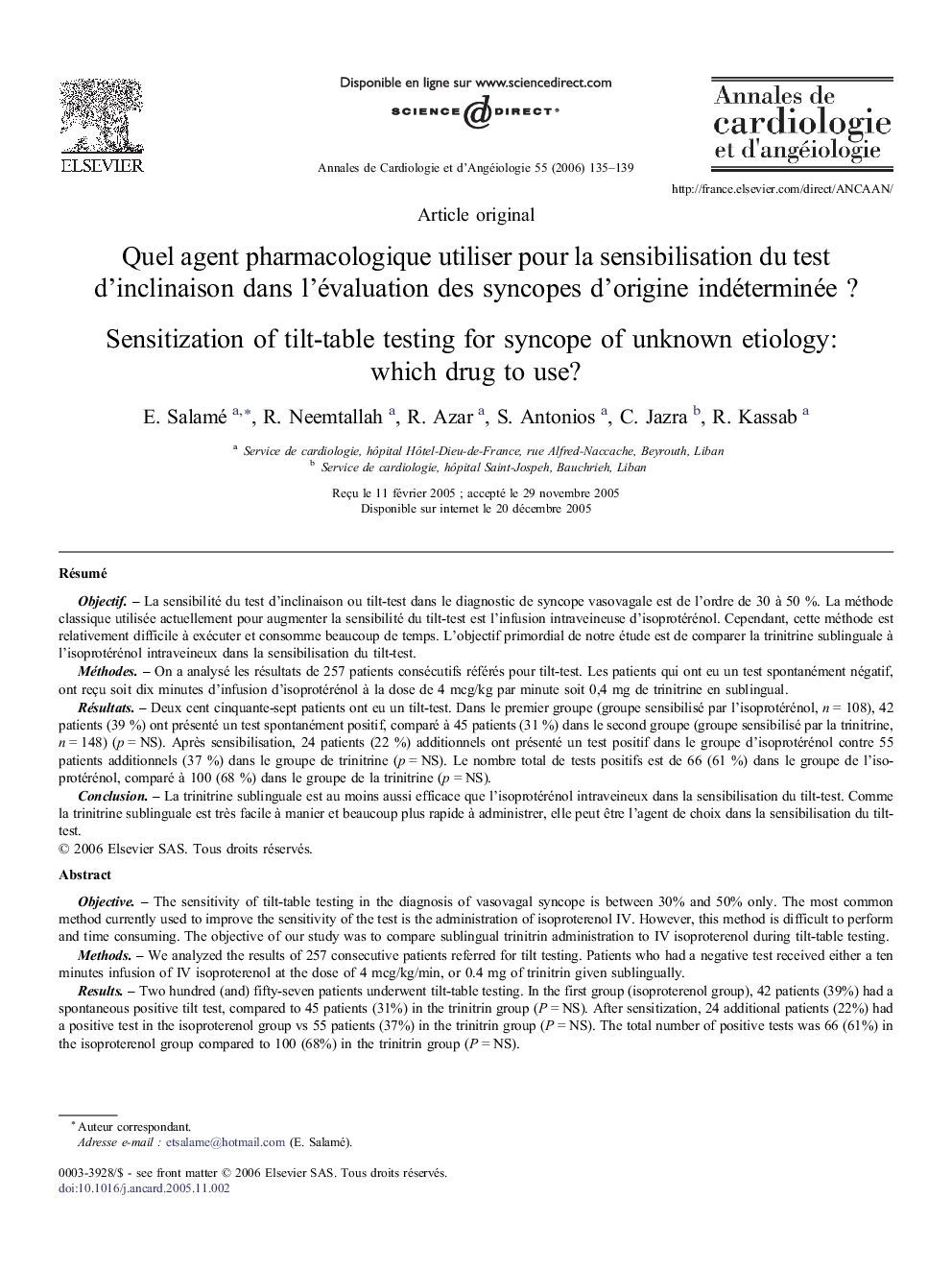| Article ID | Journal | Published Year | Pages | File Type |
|---|---|---|---|---|
| 2869651 | Annales de Cardiologie et d'Angéiologie | 2006 | 5 Pages |
RésuméObjectif. – La sensibilité du test d'inclinaison ou tilt-test dans le diagnostic de syncope vasovagale est de l'ordre de 30 à 50 %. La méthode classique utilisée actuellement pour augmenter la sensibilité du tilt-test est l'infusion intraveineuse d'isoprotérénol. Cependant, cette méthode est relativement difficile à exécuter et consomme beaucoup de temps. L'objectif primordial de notre étude est de comparer la trinitrine sublinguale à l'isoprotérénol intraveineux dans la sensibilisation du tilt-test.Méthodes. – On a analysé les résultats de 257 patients consécutifs référés pour tilt-test. Les patients qui ont eu un test spontanément négatif, ont reçu soit dix minutes d'infusion d'isoprotérénol à la dose de 4 mcg/kg par minute soit 0,4 mg de trinitrine en sublingual.Résultats. – Deux cent cinquante-sept patients ont eu un tilt-test. Dans le premier groupe (groupe sensibilisé par l'isoprotérénol, n = 108), 42 patients (39 %) ont présenté un test spontanément positif, comparé à 45 patients (31 %) dans le second groupe (groupe sensibilisé par la trinitrine, n = 148) (p = NS). Après sensibilisation, 24 patients (22 %) additionnels ont présenté un test positif dans le groupe d'isoprotérénol contre 55 patients additionnels (37 %) dans le groupe de trinitrine (p = NS). Le nombre total de tests positifs est de 66 (61 %) dans le groupe de l'isoprotérénol, comparé à 100 (68 %) dans le groupe de la trinitrine (p = NS).Conclusion. – La trinitrine sublinguale est au moins aussi efficace que l'isoprotérénol intraveineux dans la sensibilisation du tilt-test. Comme la trinitrine sublinguale est très facile à manier et beaucoup plus rapide à administrer, elle peut être l'agent de choix dans la sensibilisation du tilt-test.
Objective. – The sensitivity of tilt-table testing in the diagnosis of vasovagal syncope is between 30% and 50% only. The most common method currently used to improve the sensitivity of the test is the administration of isoproterenol IV. However, this method is difficult to perform and time consuming. The objective of our study was to compare sublingual trinitrin administration to IV isoproterenol during tilt-table testing.Methods. – We analyzed the results of 257 consecutive patients referred for tilt testing. Patients who had a negative test received either a ten minutes infusion of IV isoproterenol at the dose of 4 mcg/kg/min, or 0.4 mg of trinitrin given sublingually.Results. – Two hundred (and) fifty-seven patients underwent tilt-table testing. In the first group (isoproterenol group), 42 patients (39%) had a spontaneous positive tilt test, compared to 45 patients (31%) in the trinitrin group (P = NS). After sensitization, 24 additional patients (22%) had a positive test in the isoproterenol group vs 55 patients (37%) in the trinitrin group (P = NS). The total number of positive tests was 66 (61%) in the isoproterenol group compared to 100 (68%) in the trinitrin group (P = NS).Conclusion. – Sublingual trinitrin is at least as good as IV isoproterenol during tilt-table testing. Because trinitrin is simpler to use and because its administration is much faster than isoproterenol, it should be recommended as the drug of choice to improve the sensitivity of tilt-table testing.
